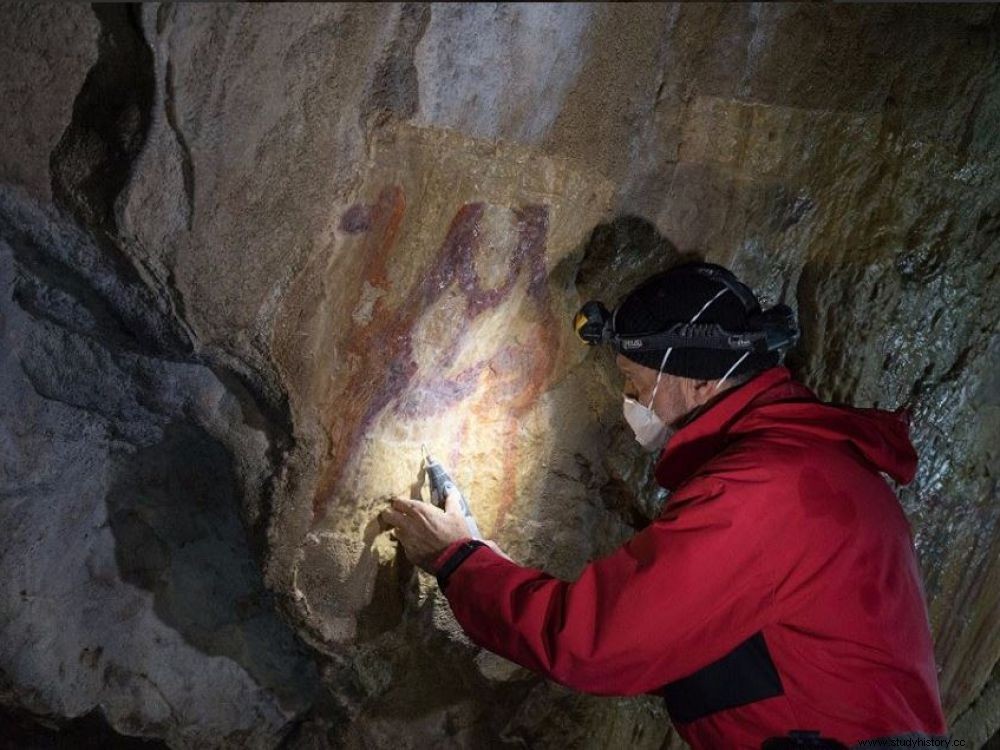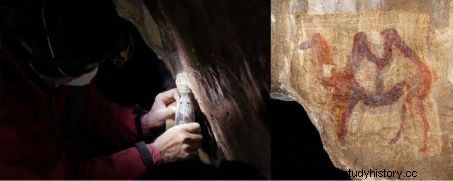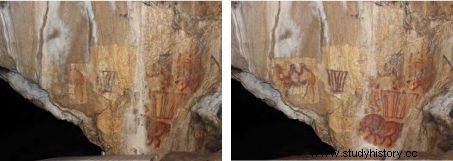A representation of a camel was discovered for the first time in Upper Paleolithic art, in the Ural steppes.

Discovery of the first prehistoric camelid in Paleolithic art.
Coming to save frescoes in a prehistoric cave in the southern Urals at the invitation of Russian researchers, a renowned restorer from the Republic of Andorra was surprised to unearth in November 2017 the figure of a camel in two humps, known as "Bactrian camel" (Camelus bactrianus ), the first ever encountered in all Upper Paleolithic art! The find was made in Kapova Cave (Shulgan Tash), an ornate cavity discovered in 1959 in the province of Bashkiria, in Bashkortorstan, a border republic with Kazakhstan.
 Eduald Guillamet revealing the figure of a Bactrian camel in Kapova Cave, Urals. © A. Pakhunov
Eduald Guillamet revealing the figure of a Bactrian camel in Kapova Cave, Urals. © A. Pakhunov
This Ice Age sanctuary was previously known for its hundred figures of woolly mammoths, horses, bison and rhinos, the effigy of the camelid native to the steppes of Central Asia having never been seen. It was in fact hidden under a thick veil of calcite, these mineral concretions formed following micro-runoffs. And it is precisely this glaze that archaeologists from the Institute of Archeology of the Moscow Academy of Sciences and their colleagues from the Heritage Center in Ufa, the capital located 250 km away, wanted to remove to access the pictorial remains. located below.
To do this, they called on Eudald Guillamet, a restorer known for his know-how already used successfully in the caves of Arcy-sur-Cure (Yonne). “To clear the calcite, I use an electromechanical cutter with a spherical diamond head. The goal being to reveal the hidden works, while always keeping a very thin film of translucent calcite for their protection”, explains the specialist.
 Kapova Cave, before and after the restoration of the prehistoric works hidden under the calcite. ©A. Pakhunov
Kapova Cave, before and after the restoration of the prehistoric works hidden under the calcite. ©A. Pakhunov
Two days of work will have been necessary to make appear the complete effigy of the 60 cm wide camelid. Its age has been estimated on the basis of dating already obtained by the so-called uranium-thorium (U-TH) method, which makes it possible to date the isotopes of uranium and thorium contained in the calcite and to deduce the age of paintings. The representation of the Bactrian camel would thus have been made at least 16,000 years ago, according to rock art specialist Ekaterina Devlet, of the Institute of Archeology of the Russian Academy of Sciences. This is a date much earlier than that retained until then for the regional presence of this animal, the oldest known archaeological traces not dating back, for its domesticated version, beyond the VII e . millennium before our era.
Predominant in the semi-desert steppes of Central Asia and Mongolia, the Bactrian camel was the main means of transport along the Silk Road. An activity that continues today as far as China. It was not until the Middle Ages that this ruminant made its appearance in Europe, unlike the African dromedary (Camelus dromedarius) used in Antiquity as a pack animal, in particular by the Roman legions returning from the East.
